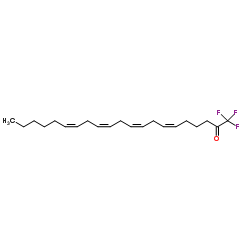Arachidonyl trifluoromethyl ketone

Arachidonyl trifluoromethyl ketone structure
|
Common Name | Arachidonyl trifluoromethyl ketone | ||
|---|---|---|---|---|
| CAS Number | 149301-79-1 | Molecular Weight | 356.465 | |
| Density | 1.0±0.1 g/cm3 | Boiling Point | 421.7±45.0 °C at 760 mmHg | |
| Molecular Formula | C21H31F3O | Melting Point | N/A | |
| MSDS | Chinese USA | Flash Point | 288.7±20.2 °C | |
|
Cytosolic phospholipase A2 plays a crucial role in ROS/NO signaling during microglial activation through the lipoxygenase pathway.
J. Neuroinflammation 12 , 199, (2015) Oxidative stress and inflammation are important factors contributing to the pathophysiology of numerous neurological disorders, including Alzheimer's disease, Parkinson's disease, acute stroke, and infections of the brain. There is well-established evidence t... |
|
|
Cytoplasmic phospholipase A₂ modulation of adolescent rat ethanol-induced protein kinase C translocation and behavior.
Neurochem. Res. 40 , 1023-31, (2015) Ethanol consumption typically begins during adolescence, a developmental period which exhibits many age-dependent differences in ethanol behavioral sensitivity. Protein kinase C (PKC) activity is largely implicated in ethanol-behaviors, and our previous work ... |
|
|
Inhibition of cytosolic phospholipase A(2) alpha protects against focal ischemic brain damage in mice.
Brain Res. 1471 , 129-37, (2012) It is postulated that inhibition of cytosolic phospholipase A(2) alpha (cPLA(2)α) can reduce severity of stroke injury. This is supported by the finding that cPLA(2)α-deficient mice are partially protected from transient, focal cerebral ischemia. The object o... |
|
|
Mechanisms for proteinase-activated receptor 1-triggered prostaglandin E2 generation in mouse osteoblastic MC3T3-E1 cells.
Biol. Chem. 396(2) , 153-62, (2015) We analyzed signaling mechanisms for prostaglandin E2 (PGE2) production following activation of proteinase-activated receptor-1 (PAR1), a thrombin receptor, in preosteoblastic MC3T3-E1 cells. PAR1 stimulation caused PGE2 release, an effect suppressed by inhib... |
|
|
Inhibitory Effect of Orientin on Secretory Group IIA Phospholipase A2.
Inflammation 38 , 1631-8, (2015) It is well known that the expression level of secretory group IIA phospholipase A2 (sPLA2-IIA) is elevated in inflammatory diseases and lipopolysaccharide (LPS) upregulates the expression of sPLA2-IIA in human umbilical vein endothelial cells (HUVECs). Orient... |
|
|
Morphine and DAMGO produce an opposite effect on presynaptic glutamate release via different downstream pathways of μ opioid receptors in the basolateral amygdala
Neuropharmacology 86 , 353-61, (2014) Increasing evidence demonstrates that different opioids, while acting μ opioid receptors, can activate distinct downstream responses, a phenomenon termed functional selectivity or biased agonism. The present study designed experiments to test whether the μ re... |
|
|
Cytosolic phospholipase A2 protein as a novel therapeutic target for spinal cord injury.
Ann. Neurol. 75(5) , 644-58, (2014) The objective of this study was to investigate whether cytosolic phospholipase A2 (cPLA2 ), an important isoform of PLA2 that mediates the release of arachidonic acid, plays a role in the pathogenesis of spinal cord injury (SCI).A combination of molecular, hi... |
|
|
Calcium-independent phospholipase A₂, group VIA, is critical for RPE cell survival.
Mol. Vis. 20 , 511-21, (2014) To investigate the significance of calcium-independent phospholipase A₂, group VIA (iPLA2-VIA), in RPE cell survival following responses to sodium iodate (SI) in cell cultures.The human retinal pigment epithelium (RPE) cell line (ARPE-19) cells and primary mo... |
|
|
Inhibition of macrophage Ca(2+)-independent phospholipase A2 by bromoenol lactone and trifluoromethyl ketones.
J. Biol. Chem. 270 , 445, (1995) A novel Ca(2+)-independent phospholipase A2 (PLA2) has recently been purified from the murine macrophage-like cell line P388D1 (Ackermann, E. J., Kempner, E. S., and Dennis, E. A. (1994) J. Biol. Chem. 269, 9227-9233). This enzyme is now shown to be inhibited... |
|
|
Evidence for de novo synthesis of lysophosphatidic acid in the spinal cord through phospholipase A2 and autotaxin in nerve injury-induced neuropathic pain.
J. Pharmacol. Exp. Ther. 333(2) , 540-6, (2010) We previously reported that lysophosphatidic acid (LPA) initiates nerve injury-induced neuropathic pain and its underlying mechanisms. In addition, we recently demonstrated that intrathecal injection of LPA induces de novo LPA production through the action of... |